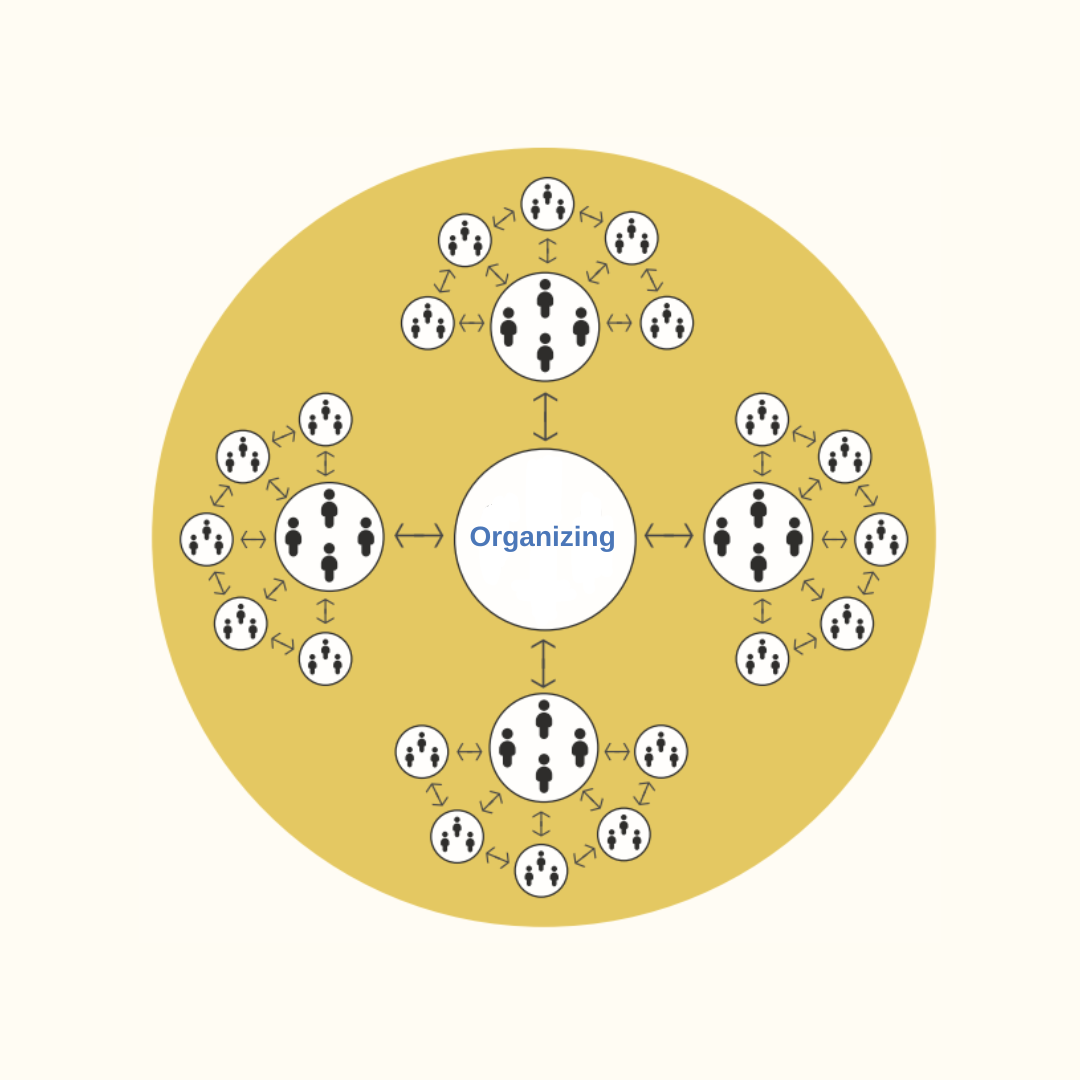What is organizing?
A short introduction to a method to organize resistance
This guide is also available in PDF format (in Dutch).
Open in PDF
What is organizing?Organizing is a strategy and method for building resistance. It is about taking leadership to enable people to use the resources they already have to push for the social change they seek. This raises several questions: Why are you the one who should take leadership within your community? How will you mobilize the people around you to join? How will you design a strategy and structure to collaborate with others? And how will you achieve your goals together? Organizing is a strategy and method that has been successfully used in labor unions, the climate movement, emancipation movements, and human rights movements to bring people together around a shared problem or common interest and drive social change. To organize effectively, you need to master certain skills. The five key ingredients of a successful organizing campaign are:
| What is organizing not?Organizing is not just about raising awareness or explaining what is wrong and how the world could be different. These types of campaigns are one-way communication—you could call it "broadcasting," like a TV program that only transmits information. Organizing, on the other hand, is a two-way process that focuses on building counterpower. Organizing is also not just about protesting, collecting petition signatures, or sharing a social media post. These approaches treat people as isolated individuals. Organizing, instead, aims to bring people together into collectives. Why is organizing so successful?Organizing works because it starts with people. Because it is a growth model in which more and more people can make a meaningful contribution to the campaign. Because it builds counterpower. Because it helps people grow, developing knowledge, talent, and leadership. Because it shares ownership with those directly involved. |
1. Tell StoriesAbout yourself and the communityShare the story of who you are and why you can and want to play a leading role in this campaign. Tell the story of the community you want to organize and what unites them. And tell a story about why this community must take action—and why they can win. A good story follows a narrative arc: it starts with an introduction, followed by action, then the climax, a setback, and finally the resolution. A compelling story includes strong characters, a plot, tension, and a setting. When you present information in a well-crafted story, it will be remembered more easily. This is far more effective than simply listing facts. An example from Peter: "In the campaign against gas extraction in Groningen, I didn’t start with ‘Hi, I’m Peter from a climate organization in Amsterdam.’ Instead, I shared that I grew up on a farm, have extensive knowledge of oil and gas extraction, and have defeated powerful opponents multiple times over the past 20 years. That’s why I felt compelled to offer my help in Groningen.” | 2. Build Intentional RelationshipsPeople as the foundation for collective actionThe best way to build relationships is through one-on-one conversations. Organizing means sitting down with people, listening, and building a connection. A one-on-one organizing conversation is not just small talk, an interview, or an explanation of what needs to be done. Instead, it is a deliberate and structured conversation aimed at truly getting to know someone while also sharing something about yourself. It’s about exploring a person’s motivations, fears, knowledge, and skills. And ultimately, it’s about securing a clear yes or no to the question of whether they are willing to take on a role or responsibility in your campaign. |
3. Build StructuresDistribute power, tasks, and responsibilitiesCreate a structure of strong teams that can work together on the campaign and are capable of forming new teams themselves. This also requires developing leadership in the people you work with. Many snowflakes make an avalanche The snowflake model is a method for organizing supporters into teams. It was popularized through the writings and workshops of Marshall Ganz and was implemented on a large scale during Barack Obama’s 2008 and 2012 election campaigns. The snowflake model gives local changemakers power and ownership to organize small teams. These key figures are the driving force behind the campaign. In an election, for example, they would organize local volunteers who go door-to-door or make phone calls to voters. In other contexts, they may organize events, engage with people at gatherings, or coordinate flyer campaigns. |  |
4. Develop a strategyCreating a plan to winWhat does the playing field look like? Who are your allies, and who are your opponents? Which key players can influence the outcome, and how can you pressure them to move in the right direction? What is the escalation ladder in your campaign? In other words, how do you start with a friendly request but escalate with each action to build pressure? And how do you secure the people and resources needed along the way to achieve victory? | 5. Your actionsTurning plans into realityActions are the concrete activities you organize—from a neighborhood meeting to a demonstration, from a lobbying conversation to blocking a street. What tactics will put pressure on your opponents? How will you tell your story? How will you motivate your supporters? How will you turn your strategy into reality? |
Finally
Organizing is something you learn by doing. Some of the best training grounds are organizations that use organizing as a method, such as labor unions. You can also read Marshall Ganz’s Organizers Handbook or organize a training session for your group with Stroomversnellers.
Interested in attending a training? Contact us here.
This guide is part of the ‘Toolbox for Movements’. This toolbox contains more short digital guides, offering fundamental knowledge about strategy, movement building, campaigning, and organizing.
We also love to learn. So, if you have any ideas for improving or adding to this guide based on your experiences, let us know!
